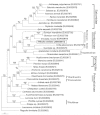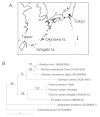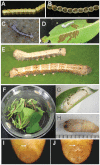Molecular phylogeny, laboratory rearing, and karyotype of the bombycid moth, Trilocha varians
- PMID: 22963522
- PMCID: PMC3476958
- DOI: 10.1673/031.012.4901
Molecular phylogeny, laboratory rearing, and karyotype of the bombycid moth, Trilocha varians
Abstract
This study describes the molecular phylogeny, laboratory rearing, and karyotype of a bombycid moth, Trilocha varians (F. Walker) (Lepidoptera: Bombycidae), which feeds on leaves of Ficus spp. (Rosales: Moraceae). The larvae of this species were collected in Taipei city, Taiwan, and the Ryukyu Archipelago (Ishigaki and Okinawa Islands, Japan). Molecular phylogenetic analyses revealed that T. varians belongs to the subfamily Bombycinae, thus showing a close relationship to the domesticated silkworm Bombyx mori (L.), a lepidopteran model insect. A laboratory method was developed for rearing T. varians and the time required for development from the embryo to adult was determined. From oviposition to adult emergence, the developmental zero was 10.47 °C and total effective temperature was 531.2 day-degrees, i.e., approximately 30 days for one generation when reared at 28 °C. The haploid of T. varians consisted of n = 26 chromosomes. In highly polyploid somatic nuclei, females showed a large heterochromatin body, indicating that the sex chromosome system in T. varians is WZ/ZZ (female/male). The results of the present study should facilitate the utilization of T. varians as a reference species for B. mori, thereby leading to a greater understanding of the ecology and evolution of bombycid moths.
Figures






Similar articles
-
Comprehensive genome annotation of Trilocha varians, a new model species of Lepidopteran insects.Sci Data. 2025 Jan 21;12(1):124. doi: 10.1038/s41597-025-04411-3. Sci Data. 2025. PMID: 39837902 Free PMC article.
-
Female sex pheromone and male behavioral responses of the bombycid moth Trilocha varians: comparison with those of the domesticated silkmoth Bombyx mori.Naturwissenschaften. 2012 Mar;99(3):207-15. doi: 10.1007/s00114-012-0887-3. Epub 2012 Feb 4. Naturwissenschaften. 2012. PMID: 22307535
-
W chromosome sequences of two bombycid moths provide an insight into the origin of Fem.Mol Ecol. 2024 Jul;33(14):e17434. doi: 10.1111/mec.17434. Epub 2024 Jun 12. Mol Ecol. 2024. PMID: 38867501
-
Sex chromosomes and sex determination in Lepidoptera.Sex Dev. 2007;1(6):332-46. doi: 10.1159/000111765. Epub 2008 Jan 18. Sex Dev. 2007. PMID: 18391545 Review.
-
Sex chromatin in lepidoptera.Q Rev Biol. 1996 Jun;71(2):239-56. doi: 10.1086/419371. Q Rev Biol. 1996. PMID: 8693060 Review.
Cited by
-
Antennal lobe organization and pheromone usage in bombycid moths.Biol Lett. 2014 Apr 23;10(4):20140096. doi: 10.1098/rsbl.2014.0096. Print 2014. Biol Lett. 2014. PMID: 24759369 Free PMC article.
-
SilkBase: an integrated transcriptomic and genomic database for Bombyx mori and related species.Database (Oxford). 2022 Jun 7;2022:baac040. doi: 10.1093/database/baac040. Database (Oxford). 2022. PMID: 35670730 Free PMC article.
-
Comprehensive genome annotation of Trilocha varians, a new model species of Lepidopteran insects.Sci Data. 2025 Jan 21;12(1):124. doi: 10.1038/s41597-025-04411-3. Sci Data. 2025. PMID: 39837902 Free PMC article.
-
The Effect of Temperature on the Development of Trilocha varians (Lepidoptera: Bombycidae) and Control of the Ficus Plant Pest.Trop Life Sci Res. 2019 Jan;30(1):23-31. doi: 10.21315/tlsr2019.30.1.2. Epub 2019 Jan 31. Trop Life Sci Res. 2019. PMID: 30847031 Free PMC article.
-
The Immature Stages, Biology, and Phylogenetic Relationships of Rotunda rotundapex (Lepidoptera: Bombycidae).J Insect Sci. 2019 Mar 1;19(2):19. doi: 10.1093/jisesa/iez025. J Insect Sci. 2019. PMID: 30953584 Free PMC article.
References
-
- Akaike H. A new look at the statistical model identification. IEEE Transactions on Automatic Control. 1974;19:716–723.
-
- Arunkumar KP, Metta M, Nagaraju J. Molecular phylogeny of silkmoths reveals the origin of domesticated silkmoth, Bombyx mori from Chinese Bombyx mandarina and paternal inheritance of Antheraea proylei mitochondrial DNA. Molecular Phylogenetics and Evolution. 2006;40:419–427. - PubMed
-
- Banno Y, Fujii H, Kawaguchi Y, Yamamoto K, Nishikawa K, Nishisaka A, Tamura K, Eguchi S. A Guide to the Silkworm Mutants 2005: Gene name and Gene Symbol. Institute of Genetic Resorces; Kyushu University: 2005.
-
- Cho S, Mitchell A, Regier JC, Mitter C, Poole RW, Friedlander TP, Zhao S. A highly conserved nuclear gene for low—level phylogenetics: elongation factor-1 alpha recovers morphology—based tree for heliothine moths. Molecular and Biological Evolution. 1995;12:650–656. - PubMed
-
- Daimon T, Hamada K, Mita K, Okano K, Suzuki MG, Kobayashi M, Shimada T. A Bombyx mori gene, BmChi-h, encodes a protein homologous to bacterial and baculovirus chitinases. Insect Biochemistry and Molecular Biology. 2003;33:749–759. - PubMed
Publication types
MeSH terms
LinkOut - more resources
Full Text Sources
Miscellaneous

